GERBERA (Gerbera jamesonii)
Compositae
Varieties
| TNAU Varieties |
: |
YCD-1, YCD-2 |
| Red |
: |
Ruby Red, Sangria |
| Yellow |
: |
Doni,Supernova, Mammut, Talasa |
| Rose |
: |
Rosalin, Salvadore |
| Pink |
: |
Pink Elegance, Marmara, Esmara |
| Orange |
: |
Carrera, Goliath,Marasol |
| Cream |
: |
Farida, Dalma, Snow Flake, Winter Queen |
Climate:
Production of quality flowers requires shade house (50%) or naturally ventilated polyhouse. Day temperature of 22-25°C and night temperature of 12-16°C are ideal. |
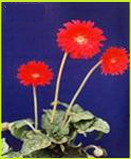 |
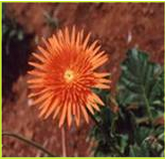 |
| YCD-1 |
YCD-2 |
|
Soil:
Well drained, rich, light, neutral or slightly alkaline soil with pH range of 5.5 - 7.0.
Season
The crop can be cultivated throughout the year.
Propagation:
Commercially propagated through division of suckers and tissue culture plants.
Field preparation and planting:
Soil fumigation withFormaldehyde (100ml in 5l/m2) or Dazomet (30g/m2) is recommended to control soil borne pathogens (Phytophthora, Fusarium and Pythium). Raised beds of 1-2m width and 30cm height are prepared. Growing media consisting of FYM: sand: cocopeat/paddy husk (2:1:1) is ideal. |
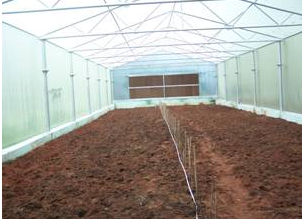 |
| Media preparation |
|
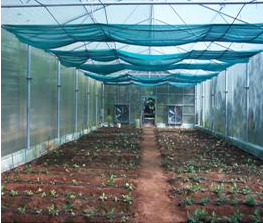 |
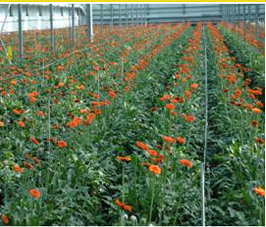 |
| Greenhouse cultivation of gerbera |
|
Before starting gerbera cultivation, disinfection of the soil is absolutely necessary to minimize the infestation of soil borne pathogens like Phytophthora, Fusarium and Pythium which could otherwise destroy the crop completely. The beds should be drenched / fumigated with 2% formaldehyde (100 ml formalin in 5 litres of water / m2 area) or methyl bromide (70 g / m2) and then covered with a plastic sheet for a minimum period of 2 to 3 days. The beds should be subsequently watered thoroughly to drain the chemicals before planting. Well developed tissue culture plants having 4-6 leaves can be planted firmly without burying the crown.
Spacing:
40 x 30 cm or 30 x 30 cm
Irrigation
Drip irrigation is done once in 2 – 3 days @ 3.75 litre/drip/plant for 15 – 20 minutes. Average water requirement is about 500 – 700 ml/day/plant.
|
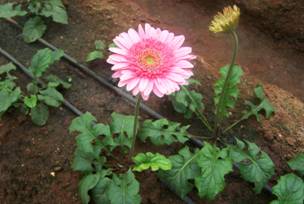 |
| Drip irrigation for gerbera |
|
Nutrition: Fertigation is adopted from 3rd week after planting as per the following schedule.
Fertilizer |
Quantity (g/500m2) |
| A tank (Monday, Wednesday, Friday) |
| Calcium Nitrate |
700 |
| Pottasium Nitrate ( 13:0:46) |
400 |
| Fe EDTA / sulphate |
20 |
| B tank (Tuesday, Thursday, Saturday) |
| Mono Ammonium Phosphate (12:61:0) |
300 |
| Sulphate of Potash (0:0:50) |
700 |
| Magnesium Sulphate |
700 |
| Manganese Sulphate |
5 |
| Zinc Sulphate |
3 |
| Copper Sulphate |
3 |
| Molybdenum (Sodium Molybdate) |
1 |
| Boron (Borax) |
3 |
Manuring
Basal
Neem cake 2.5 ton/ha
P - 400 g/100 sq.ft.
MgSo4 - 0.5 kg/100 sq.ft.
Top dressing
Calcium Ammonium Nitrate and Muriate of Potash at the ratio of 5:3 is mixed and applied at 2.5 g/plant/month.
Aftercultivation
1. Hand weeding is done whenever necessary.
2. Remove the flower buds up to 2 months and then allow for flowering
3. Rake the soil once in 15 days to facilitate easy absorption of water, fertilizer and to provide air to the roots.
4. Remove older leaves to facilitate new leaf growth and good sanitation.
Special practices
Leaf pruning:
Remove old leaves periodically
Plant protection
Pests
Aphids:
Apply Imidacloprid 17.8 % SL @ 1 ml/l or Dimethoate 30 EC @ 2 ml/l
Whitefly:
Spray Imidacloprid 17.8 % SL @ 2 ml/l or Dimethoate 30 EC @ 2 ml/l
Thrips:
Spray Fipronil @ 2 ml/l or Dimethoate 30EC @ 2 ml/l
Red spider mite:
Spray Abamectin 1.9 EC @ 0.4 ml/l or Propargite @ 1 ml/l
Nematode:
Soil application ofBacillus subtilis (BbV 57)or Pseudomonasfluorescens @ 2.5 kg/ha at the time of planting for the management of root knot nematode.
Diseases:
Flower bud rot: Spray copper oxychloride @ 2 g/l
Powdery mildew: Spray wettable Sulphur @ 2g/l or Azoxystrobin @ 1g/l
|
Season of flowering and Harvesting :
When flowers completely open, harvesting is done. Flower stalk is soaked in Sodium hypochloride solution (5-7 ml/lit of water) for 4-5 hours to improve vase life.
Post harvest handling:
Harvesting is done when outer 2-3 rows of disc florets are perpendicular to the stalk. The heel for the stalk should be cut about 2-3 cm above the base and kept in fresh chlorinated water. Flowers should be graded and sorted out in uniform batches. Flowers packed individually in poly puches and then put in to carton boxes in two layers.
Bushiness:
An abnormality characterized by numerous leaves, short petioles and small laminae, which gives some cultivars of gerbera a bushy appearance known as bushiness. Nodes are not clearly distinguished and no internode elongation is seen. |
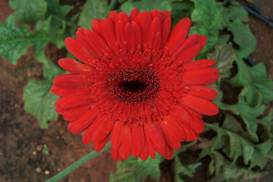 |
| Gerbera ready for harvest |
|
Stem break
It is a common post harvest disorder in cut gerberas. This is mainly caused by water imbalances. It could be ethylene controlled and associated with early senescence caused by water stress.
Yellowing and purple margin
Nitrogen deficiency causes yellowing and early senescence of leaves. Phosphorus deficiency causes pale yellow colour with purple margin. Increase in levels of nitrogen and phosphorus were found to promote development of suckers and improve flowering in gerbera.
Grading
Based on stem length and diameter, flowers are graded in A, B, C and D.
Yield
The crop yields 2 stems / plant / month. Harvest starts from 3rd month of planting and continued up to two years. Under open condition, 130 -160 flowers / m2 / year and under greenhouse condition, 175 - 200 flowers /m2/ year can be obtained.
Source
1. http://www.starfiber.com/image.php?id=182&type=Gerbera%20Substrate
2. http://image59.webshots.com/759/5/14/95/2838514950026222415OIwUdq_fs.jpg |
|







